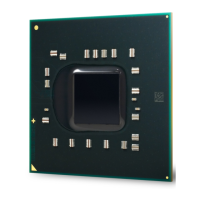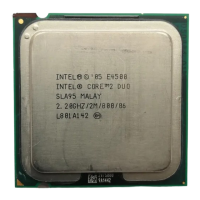Intel Thermal/Mechanical Reference Design Information
Thermal and Mechanical Design Guidelines 47
A list of failure mechanisms that were considered in design reliability testing are:
1. Pump assembly cracking causing liquid loss
2. Vapor loss through plastic walls and joints causing liquid loss
3. Thermal performance degradation due to internal mechanisms affecting
CPU T
C
temperature
4. Pump motor and printed circuit board performance degradation affecting
the pump RPM
All of the above mechanisms are expected to be active during the pump operation and
relatively inactive during the off mode and so all reliability testing needs to be
performed with pump on. The fatigue mechanisms (# 1) are additionally excited by
the cycling of temperature caused by on-off cycles. The real use condition is a
combination of continuous operation and on-off cycling and for the purpose of testing
can be separated into a) continuous operation and b) on-off power cycles. The liquid
temperature during continuous operation can be estimated by the heat exchanger
thermal resistance, TDP, and T
A
(e.g., at T
A
= 38 ºC, TDP = 130 W, and
Ψ
HX
= 0.05 ºC /W gives T
LIQUID
= 45 ºC). The calculated T
LIQUID
when fan is at its low
speed and T
A
= 26 ºC is expected to be approximately the same. A typical on-off cycle
can be assumed to be from ambient condition to T
LIQUID
= 45 ºC. The pump speed is
also controlled similar to a fan for acoustics and expected mean pump RPM was
estimated to be 1450 (range = 600-1700). The pump speed of 1450 was used to
simulate typical condition during with use condition.
Note: The heat exchanger thermal resistance, Ψ
HX
= (T
LIQUID
– T
A
)/(CPU power). T
A
is the air
approaching the heat exchanger.
The complete test matrix is summarized in the
Table 6. The continuous operation tests
were slightly accelerated to reduce duration for failure. The cracking mechanism #1
was accelerated significantly by running at 75 ºC. The T
LIQUID
value was achieved by
applying a film heater to the bottom of the pump assembly alone (tubing and heat
exchanger were not included by a closed loop tube was used to provide impedance
from pump outlet to inlet).
Table 6. The Reliability Test Matrix
Use Condition Test Conditions Pump Speed Included Failure
Mechanisms
Continuous operation T
LIQUID
= 50 ºC 1450 2
T
LIQUID
= 50 ºC 1450 3, 4
T
LIQUID
= 75 ºC for 16
weeks
1450 1
On-off cycles T
LIQUID
= 35-60 ºC,
7500 cycles
1450 1,2,3,4

